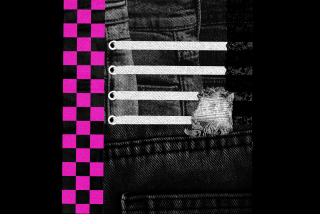The Fashion Fight : How much control should youngsters have over their wardrobes? Depends on which expert you listen to.
To obey or not to obey: That is the question kids ponder when parents lay down their fashion edicts.
Offending offspring may not realize it, but parents face a parallel dilemma. How much freedom should they allow when it comes to attire? Should they encourage conformity with their child’s peers? Do they draw the line when it comes to ripped jeans or a nose ring?
Suzy Gershman, parent and author of the “Born to Shop” book series, believes in flexibility.
“It is one of the few areas of control where little damage can be done,” she says. “It’s better to give in on this issue and stick to your guns on more important values.”
The Connecticut-based author has a 13-year-old son who wears what he likes. Up to now, he has not asked his mother for permission to get his ear pierced, though she fully expects he will.
“I haven’t made up my mind yet, but I will probably let him if he does,” she says.
Not everyone agrees with Gershman that total freedom is the best approach where children’s fashion is concerned. Eleanor Hedvig, a psychologist based in Northridge, says parents who are too indulgent with their children are doing them a disservice.
“Too many parents allow their children to believe anything goes in society,” Hedvig says. If parents don’t set limits, “children do as they please and that kind of freedom can lead to tagging and other rebellious activities.” Kids with absolutely no limits on their dress, she says, end up wearing clothing intended to shock and defy parents.
The best balance, she says, is achieved by parents who exercise some control over fashion selections beginning when their children are small. Surprisingly, even very young children may develop an interest in what they wear.
Take Jeanne Troyanek’s 2-year-old, Alyssa Atman. The Sherman Oaks mom says her daughter began “coordinating her own clothing” when she was about a year old. Like many toddlers, Alyssa prefers anything with Barney, Minnie Mouse or characters from “Beauty and the Beast” plastered all over it.
“I always said I’d never allow my child to wear advertisements like that, but that’s all she wants to wear,” Troyanek says, “so what can I do? I just want her to be happy.”
Troyanek, a swimsuit designer, says her child will wear things Mom picks out, but never coordinates outfits as she originally envisioned them.
“Sometimes I wince at her choices,” Troyanek says, “but I figure . . . why force her to conform to my wishes?”
Parents of older children say the real battles begin as children start to bond with peers. The acceptance of their friends often supersedes their desire for their parents’ approval, and clothing becomes a control issue. At this point, Hedvig says, the child who has accepted some limits will be able to make more responsible choices than the kid who has done as he or she pleased.
She recommends that parents start shopping with their children at an early age, slowly allowing them some freedom of styles but drawing the line at offensive or ultra-expensive items. As the child learns to handle responsibility, more can be granted.
Such restraint, she says, is hard for some parents.
“Too often the parents let the children set the standard because of guilt,” she says. This often happens when both parents work full time and use possessions to make up for the lack of family togetherness.
Sometimes a miraculous meeting of the minds occurs, as in the case of the Hariton family of West Hills. The kids and their friends happen to have conservative taste, so the parental stamp of approval comes easily.
“They wouldn’t let me out of the house in provocative clothing, but I wouldn’t wear it anyway,” says 14-year-old Hillary Hariton. The teen-ager, says her mother, Sydney, usually accompanies her on shopping trips. Though they don’t always agree on styles, her mother rarely forbids anything outright. The only item she recalls vetoing for her daughter was a pair of cutoffs she considered too informal for school. She also says she wouldn’t let her son, Spencer, 12, wear any exaggerated hip-hop style shorts, but so far, she reports, he hasn’t wanted to.
Hedvig says that once children learn to make sound choices and parental approval follows, a far more valuable lesson has been learned than just fashion coordination.
“Kids do have a right to express themselves in the fashions they wear,” she says. “By giving the child a little responsibility, he or she learns to make good judgment calls and develop sound values.”
More to Read
Sign up for our Book Club newsletter
Get the latest news, events and more from the Los Angeles Times Book Club, and help us get L.A. reading and talking.
You may occasionally receive promotional content from the Los Angeles Times.






